Travels in New Zealand: Week Two
Hamilton – Matamata – Lake Taupo – Wellington

* Art and War. In Hamilton to meet my editor, Suzanne, and talk over revisions to my latest military book, we were lucky enough to see a statue of the New Zealand soldier, map-maker and war-artist, Sapper Horace Moore-Jones, being lowered onto its plinth of Gallipoli stone in the main street. It’s a fine bronze by Matt Gauldie, himself a serving soldier, who was there supervising the work. It shows the sapper with a rifle on his back, pencil and sketchbook in hand. Moore-Jones was a Hamilton man, and this is one of the city’s significant Anzac centenary commemorations. A fine one, too, given that the sapper also painted the notable picture of a Gallipoli stretcher-bearer (sometimes wrongly referred to as Simpson) The Man With The Donkey.
* The good news is that Suzanne liked the book, its essential flow and structure, and it took only a couple of hours and several strong coffees to discuss the main areas where more works needs to be done. Time shifts, re-pointing sections of dialogue, perhaps sharpening the high points of the drama. That sort of thing. Nothing major. Which gave us
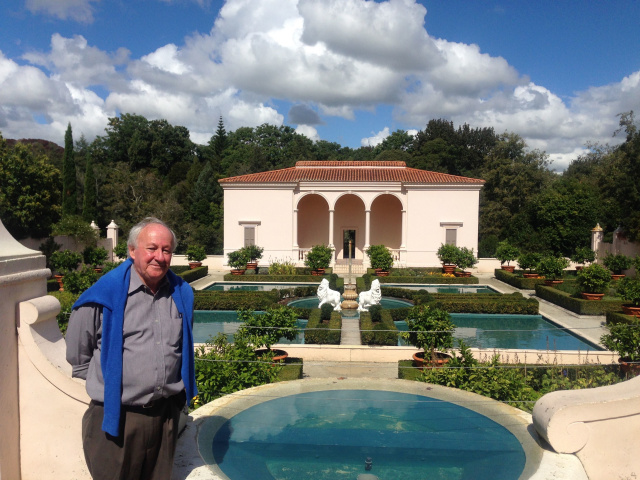
time afterwards for a walk in the Hamilton Gardens. What a revelation! Apart from the lawns and arbours, there are a series of beautifully planted gardens on specific themes … a Tudor Garden … Japanese Garden, Chinese, Italian Renaissance, walled vegetable garden, and so on, many of them overlooking the broad and swift-flowing Waikato River. Among the favourites was this Indian Garden, with its pavilions, fountains and formal beds planted with red, blue and yellow flowers, like a Moghul carpet. The blooms are beginning to fade now with autumn setting in, but they’re still exquisite.
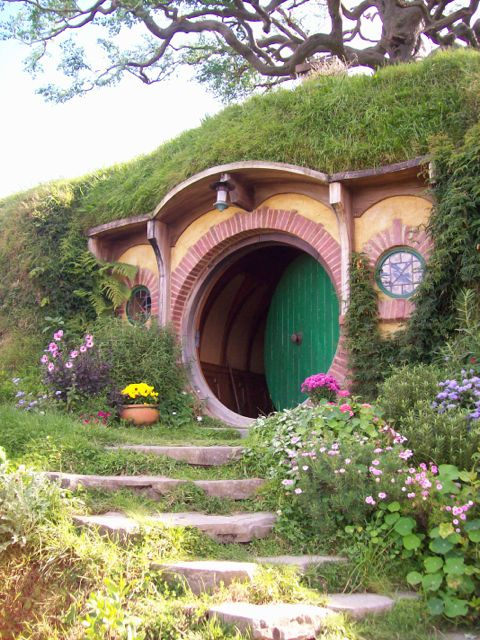 * Middle Earth. From the Pacific resonances of Northland, we’re travelling south into the regions that might nicely be called Middle Earth. Here among these landscapes, Peter Jackson shot his two masterful trilogies based on J.R.R. Tolkien’s The Lord Of The Rings and The Hobbit. To the 1250 hectare farm outside Matamata where, in a charming (and necessarily secluded) vale of green hills, a lake and a large party tree, Hobbiton was created. Re-created, too, in permanent materials when they made the second trilogy, and now operated very well by the farmers and film makers as guided tours for the many thousands of movie fans – like ourselves – who want to revisit what was a powerful artistic experience.
* Middle Earth. From the Pacific resonances of Northland, we’re travelling south into the regions that might nicely be called Middle Earth. Here among these landscapes, Peter Jackson shot his two masterful trilogies based on J.R.R. Tolkien’s The Lord Of The Rings and The Hobbit. To the 1250 hectare farm outside Matamata where, in a charming (and necessarily secluded) vale of green hills, a lake and a large party tree, Hobbiton was created. Re-created, too, in permanent materials when they made the second trilogy, and now operated very well by the farmers and film makers as guided tours for the many thousands of movie fans – like ourselves – who want to revisit what was a powerful artistic experience.
* It was a fantasy, of course; but its strength was the unified vision sustained by the designers, craftspeople, actors and production team across six films. Jackson always said the approach was as if they were filming history – and the intelligent and meticulous attention to detail given to each of the created ‘cultures’ is what breathes life into the concept. So at Hobbiton, the growing gardens, the hobbit-sized tables and stalls and washing lines, the round painted doors of the hobbit holes… I remember the carved design in one small wooden shutter, weathered and now almost hidden behind green leaves, but nevertheless there! The doors are of varying sizes, to suit (on screen) either large persons or small. Though I’m happy to report that The Green Dragon Inn, where refreshments are served, was definitely at human scale.
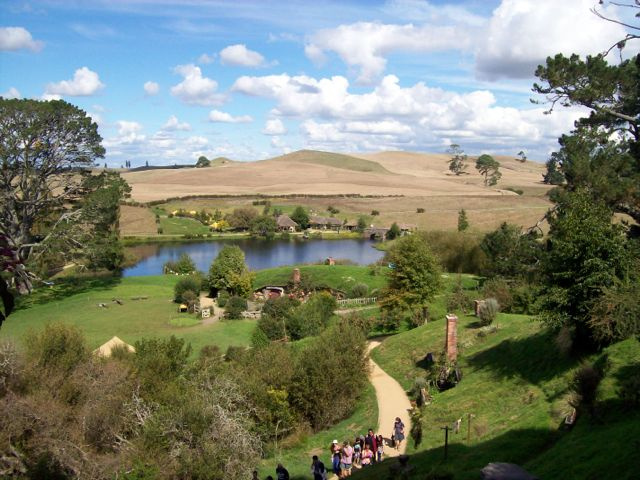
* It was entirely fortuitous that Jackson is a New Zealander and shot the films here. It’s a country that – cinematically – was not widely known, yet in so many ways the landscape reflects the Middle Earth described by Tolkien. From the very English countryside around Matamata, (there are even hedgerows), we went to Lake 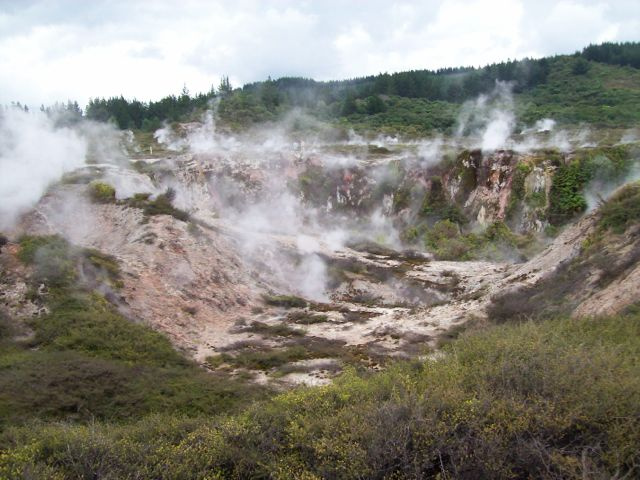 Taupo in the central volcanic regions. Here the land speaks of the earth in an earlier stage of its formation, as indeed New Zealand is geologically a relatively young country. We spent an hour and a half walking around the ‘Craters of the Moon’ site, where craters and fissures hiss with boiling geothermal steam, mud and water bubbles, the earth and rocks are warm, and the air is heavy with the smell of sulphur.
Taupo in the central volcanic regions. Here the land speaks of the earth in an earlier stage of its formation, as indeed New Zealand is geologically a relatively young country. We spent an hour and a half walking around the ‘Craters of the Moon’ site, where craters and fissures hiss with boiling geothermal steam, mud and water bubbles, the earth and rocks are warm, and the air is heavy with the smell of sulphur.
* It’s much less commercial than Rotorua – very few other people were there – and I fancy all the more powerful an experience for that. In fact new eruptions happen quite frequently, and the walking track has to be shifted. Nor was it just Vulcan at work.
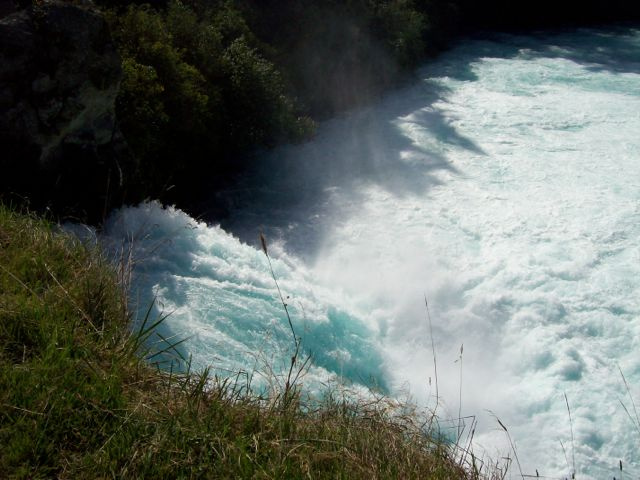
* Not far away, at the Huka Falls, we saw the elemental forces of nature in another guise. Here, the Waikato river begins its 450 km journey to the sea – the water flowing from Lake Taupo and boiling as it races through the narrow gorge … cutting and raging through the rock, cascading in a maelstrom over the nine-metre falls. After Jackson, I can imagine elven canoes making that journey … though today a jet boat instead takes thrill-seekers shooting the rapids. I’m afraid they would have to pay us!
 * The raw and fundamental nature of this Middle Earth was brought very much to mind during a spectacular drive south from Taupo. The vast lake, tranquil blue with the morning mist rising … and beyond three majestic volcanoes. Mounts Tongariro, Ngauruhoe, and Ruapehu. The latter two, in particular, stand like sentinels as you drive across the sparse upland, purple now with heather, though before long it will be covered with snow.
* The raw and fundamental nature of this Middle Earth was brought very much to mind during a spectacular drive south from Taupo. The vast lake, tranquil blue with the morning mist rising … and beyond three majestic volcanoes. Mounts Tongariro, Ngauruhoe, and Ruapehu. The latter two, in particular, stand like sentinels as you drive across the sparse upland, purple now with heather, though before long it will be covered with snow.
Ngauruhoe is the perfect volcanic cone – the first I have ever seen: barren, ash-covered and nether-worldish. Ruapehu more sprawling, already with snow in its hollows, though no less dystopian. Here, they shot the scenes of Mount Doom, from the final part of LOTR, where the cursed ring was at last cast back to the fires from which it had been forged.
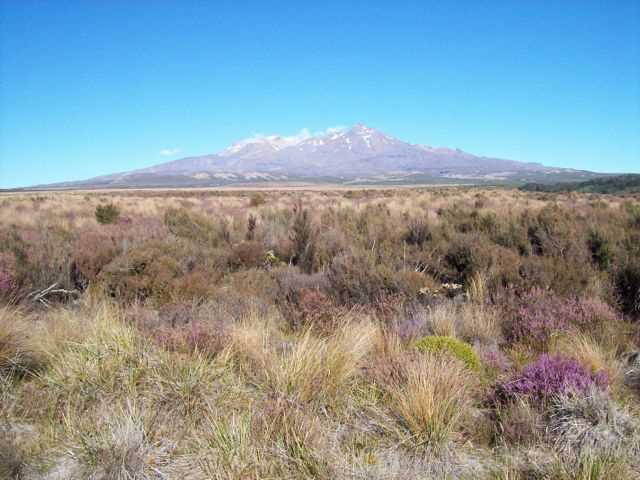
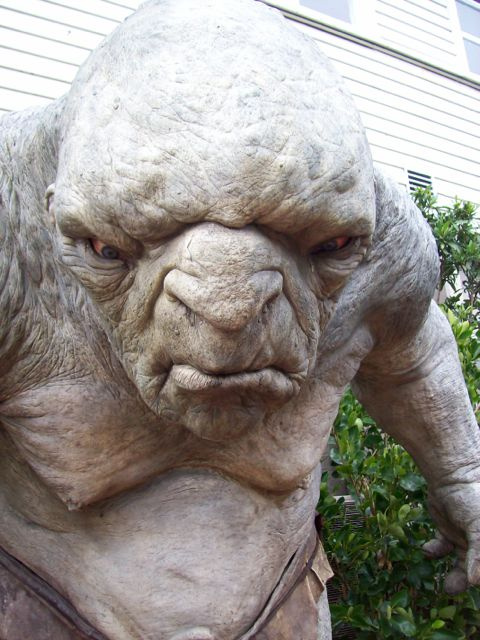
* So, to complete another leg of this journey, to Wellington, and an early afternoon visit to the Weta Workshop (‘Weta Cave’), where the scenery, props, and many of the costumes for the Tolkien films (and others) were designed and made. Greeted by the three mountain trolls at the front door; and while there are few original costumes or accoutrements on display (they are all owned by the various studios, hence no photographs) it was very good to be reminded through these fine replicas of the care, thought, and loving attention to detail that went into them from these same artists. We saw, in fact, the master swordsmith at work in his forge, and the creative skill of a wig-maker attaching one hair at a time to a costume.
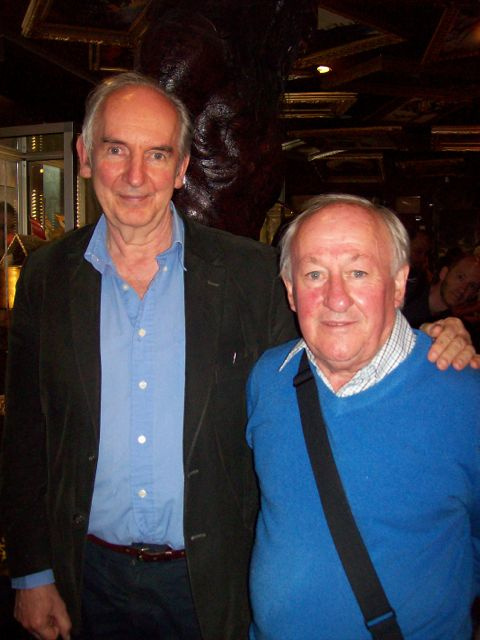
* Indeed, what could be a more fitting end to this part of our trip than to meet one of those key creative minds. Alan Lee, who was conceptual artist for the Tolkien series with John Howe, happened to be at Weta for a brief book-signing before returning to England. I took the opportunity to have him sign a copy of The Hobbit, and to thank him for the very great pleasure he has given myself and millions of people around the world with the skill and penetration of his artistry. Tolkien wrote one of the masterpieces of 20th century literature. The way in which Peter Jackson, Alan Lee and their colleagues conceived and executed a vision of how that might properly be realised on film, gave us one of the masterpieces of contemporary cinema. Like any star-struck tourist, I could do no less than ask to take a photo. Which Mr Lee very kindly obliged by offering to pose together.
Photo credits| First two photographs, Suzanne Wilson, with thanks. Remainder taken by author (and one nice passing visitor).
